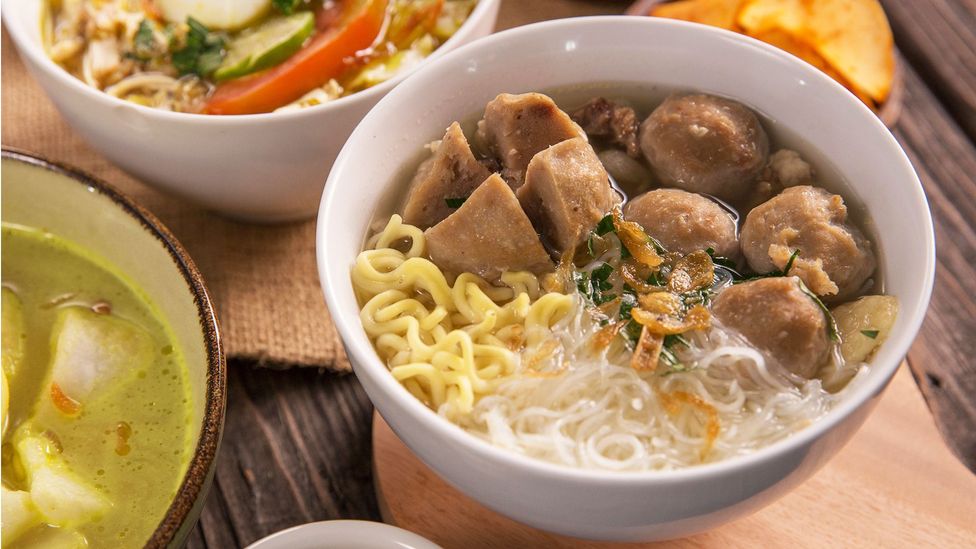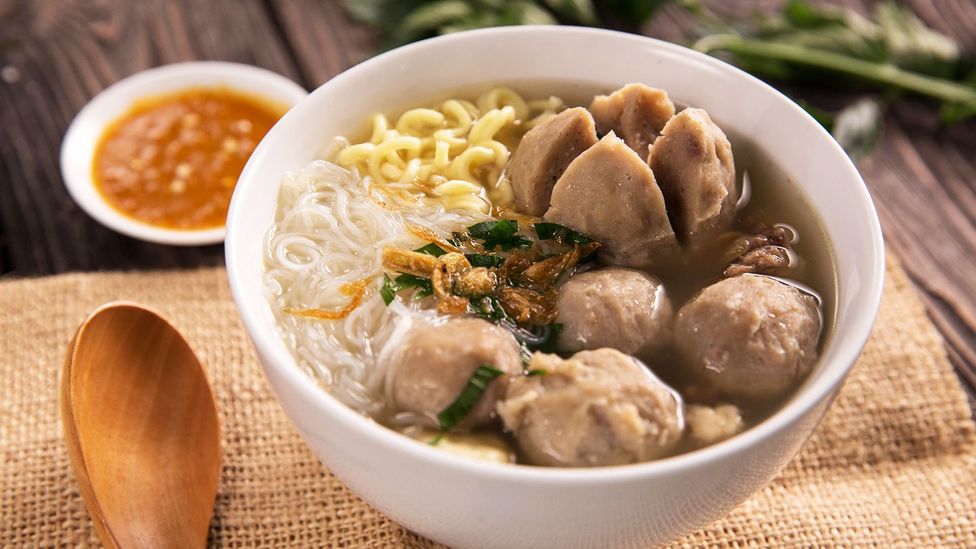On a 2010 state visit to Indonesia, former US president Barack Obama delivered an unforgettable comment during his dinner speech: "Bakso, nasi goreng... semuanya enak!", or "Meatball soup, fried rice... it's all delicious!"
A staple in the country where Obama spent four years of his childhood, Indonesia's mie bakso is a warm, hearty bowl of meatball noodle soup. Between his several testaments to the dish's exceptional flavour and candid shots of the politician enjoying the dish at restaurants like the Grand Garden Café in Bogor, Indonesia, mie bakso has become known as one of Obama's favourite soups.
Obama isn't alone in his appreciation of mie bakso; the dish is much loved by locals spanning the islands of Indonesia. The soup is especially adored where it was created: in the capital of Jakarta, situated on the world's most populous island of Java. When writing her cookbook, The Indonesian Table, author Petty Pandean-Elliot was sure to include her own experience growing up in Jakarta, as well as insights into the identity of Indonesian cuisine and, of course, the legacy of mie bakso.
"We catch up through food, we share happiness through food, we share sadness through food," she said. "Food has a big role in everyday life. We have 17,000 islands, 1,000 different ethnicities, 700 languages, and I think as a country, that is magnificent, and I want to celebrate it more and to share with the world that we have this amazing diversity."
Pandean-Elliot explained that the flavour profile of mie bakso is just as complex as the makeup of Indonesia, so the key to constructing a successful bowl is understanding its components. Each bowl is a marriage of rice noodles, a broth of seasoned meat and vegetables, and finely minced, flavourful beef meatballs. It is customary to garnish the soup with crispy shallots and celery leaves. Some variations are also topped with a hard-boiled egg, tofu and beansprouts, which add additional texture, flavour and personality to the soup. Pandean Elliot also serves her mie bakso with light soy sauce, Sriracha, tomato sauce (ketchup) and vinegar, and, most importantly, the Indonesian chilli paste known as sambal. The resulting soup is spicy, tangy and hearty – a flavour profile that is reflective of the national cuisine.

In The Indonesian Table, author Petty Pandean-Elliot was sure to include her own experience growing up in Jakarta (Credit: Petty Pandean-Elliott)
"I know it's [a] very strange combination, isn't it? But I think [it] represents the diversity in Jakarta, the melting pot of people and the culture in one bowl, so I find it fascinating actually," said Pandean Elliot.
She describes Java cuisine as "diverse" explaining that croquettes, which are popular with Indonesian bakers and street vendors, were likely introduced during Dutch colonialism in the late 16th Century. Chillies, which are at the heart of spicy Indonesian dishes, were a result of trade with Spanish and Portuguese merchants around the same time. And bakso (meatballs) are said to be a product of 13th-Century Chinese immigration, due to the resemblance to the texture and flavour of Chinese fish balls and meat balls.
Just as these countries have influenced Indonesia, this dynamic group of islands have had an immeasurable impact on the world's cuisine. According to Pandean-Elliot, the mace, nutmeg and cloves sourced from the archipelago that has been dubbed the "Spice Islands" have played a crucial role in the development of internationally recognised staples, "from Chinese five spice and Indian garam masala to North African ras-el-hanout and baharat to the French quatre épices and Dutch speculaas," she said. The archipelago's culinary influence extends even further with the widespread popularity of dishes like tempeh, nasi goreng (fried rice), satay, and the secret to mie bakso's flavourful heat, sambal.
"Sambal is condiment that brings extra flavours to the dish," explained the chef, who includes a dozen variations of the chilli sauce in her book. "[It] is the most important aspect of Indonesian food culture because [we] just like very, very spicy food."
Bursting with flavour, heat and a level of spice rivalling that of his own famous chili recipe, it's no surprise that Obama feels at home with a bowl of mie bakso.

Each bowl is a marriage of rice noodles, a broth of seasoned meat and vegetables, and finely minced, flavourful beef meatballs (Credit: Robbi Akbarki Kamaruddin/Alamy)
Ingredients
For the beef stock:
2kg/4.8lb beef bones, fat trimmed
8 garlic cloves, coarsely chopped
3 celery stalks
2 whole nutmeg, coarsely ground with a mortar and pestle
1 tbsp sea salt
1 tbsp ground white pepper
For the sambal:
2-3 red bird's eye chillies
1 large red chilli
1 clove garlic
1 tbsp sugar
salt to taste
For the meatballs:
2 tbsp sunflower oil
8 garlic cloves, finely chopped
500g/1.2lb beef topside (top round), fat removed and coarsely chopped
1 tsp ground white pepper
1 egg
200g/7oz (1½ cups) tapioca flour
For the noodles and condiments:
300g/10½oz fresh or dried rice noodles
4 large pak choy, halved and cut into 1cm/½in lengths
2 tsp rice or apple cider vinegar
4 tbsp tomato sauce (ketchup)
4 tbsp sweet soy sauce
4 tsp light soy sauce
4 tsp Sriracha
4 tbsp crispy shallots
2 tbsp chopped celery leaves
Method
Step 1
To make the stock, combine the beef bones and 2 litres/2 quarts of water in a stockpot and bring to a boil. Drain, then rinse the bones. This assures a clear broth.
Step 2
In the same stockpot, combine the bones, garlic, celery, nutmeg, salt and pepper. Add 2 litres/2 quarts of water and bring to a boil. Reduce the heat to medium-low, then cover and simmer for 2–3 hours. Strain the broth into a medium saucepan and set aside.
Step 3
To make the sambal,bring a small saucepan of water to a boil. Add the chillies, garlic and sugar and boil for 6–8 minutes, until softened. Reserve 4 tablespoons of the water, then drain. Transfer the mixture to a blender and blend until smooth. If needed, add the reserved water to loosen the mixture to the desired consistency. Season to taste with salt.
Step 4
To make the meatballs, heat the oil in a small frying pan over medium heat. Add the garlic and sauté for 1–2 minutes until golden brown. Set aside.
Step 5
In a blender or food processor, combine the fried garlic, meat and pepper and process until fine. Add the egg, tapioca flour and 50ml/¼ cup cold water and mix until smooth.
Step 6
Fill a saucepan halfway with water and bring to a simmer. Scoop a small handful of the meatball mixture in one hand and make a gentle fist. Gently squeeze the paste up through the hole between your thumb and index finger until you have a small ball about the sizeof a large grape. Scoop the meatball with your other hand and gently lower it into the pan. Repeat with the remaining mixture. Simmer the meatballs for 6–7 minutes until they float to the surface. Using a slotted spoon, remove one of the meatballs and cut it in half to check that it's cooked through.
Step 7
Put the meatballs into the broth and bring to a boil. Reduce the heat to medium-low and simmer for 10 minutes.
Step 8
To make the noodles, prepare the noodles according to the package directions. Drain, then transfer to a bowl of cold water. Drain again, then set aside.
Step 9
Add the pak choy to the broth and cook for 45 seconds. Using a slotted spoon, transfer the pak choy to a plate.
Step 10
Place the noodles into individual bowls and add the pak choy. Top with 3–4 meatballs, then ladle 2 spoons of broth into each bowl. Season each bowl with vinegar, tomato sauce, soy sauces and Sriracha. Sprinkle with crispy shallots and celery leaves. Serve immediately with the sambal.
Tip
The meatballs are traditionally minced by hand, using two cleavers on a chopping board to create a fine meatball paste. Still, it's time-consuming (and, arguably, dangerous for the uninitiated). A blender or food processor works perfectly well in the home kitchen. It'll serve you well to prepare a big batch of the meatballs and freeze them when you need a quick topping for fried rice, noodles or stir-fried vegetables.
BBC.com's World's Table "smashes the kitchen ceiling" by changing the way the world thinks about food, through the past, present and future.
---
Join more than three million BBC Travel fans by liking us on Facebook, or follow us on Twitter and Instagram.
If you liked this story, sign up for the weekly bbc.com features newsletter called "The Essential List". A handpicked selection of stories from BBC Future, Culture, Worklife and Travel, delivered to your inbox every Friday.
